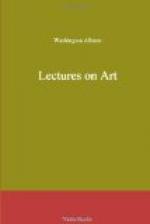Form.
The subject proposed for the following discourse is the Human Form; a subject, perhaps, of all others connected with Art, the most obscured by vague theories. It is one, at least, of such acknowledged difficulty as to constrain the writer to confess, that he enters upon it with more distrust than hope of success. Should he succeed, however, in disencumbering this perplexed theme of some of its useless dogmas, it will be quite as much as he has allowed himself to expect.
The object, therefore, of the present attempt will be to show, first, that the notion of one or more standard Forms, which shall in all cases serve as exemplars, is essentially false, and of impracticable application for any true purpose of Art; secondly, that the only approach to Science, which the subject admits, is in a few general rules relating to Stature, and these, too, serving rather as convenient expedients than exact guides, inasmuch as, in most cases, they allow of indefinite variations; and, thirdly, that the only efficient Rule must be found in the Artist’s mind,—in those intuitive Powers, which are above, and beyond, both the senses and the understanding; which, nevertheless, are so far from precluding knowledge, as, on the contrary, to require, as their effective condition, the widest intimacy with the things external,—without which their very existence must remain unknown to the Artist himself.
Supposing, then, certain standard Forms to have been admitted, it may not be amiss to take a brief view of the nature of the Being to whom they are intended to be applied; and to consider them more especially as auxiliaries to the Artist.
In the first place, we observe, that the purpose of Art is not to represent any given number of men, but the Human Race; and so that the representation shall affect us, not indeed as living to the senses, but as true to the mind. In order to this, there must be all in the imitation (though it be but hinted) which the mind will recognize as true to the human being: hence the first business of the Artist is to become acquainted with his subject in all its properties. He then naturally inquires, what is its general characteristic; and his own consciousness informs him, that, besides an animal nature, there




